Chords, believe it or not, are a great tool for soloing on your acoustic guitar. Beyond their many obvious uses, chords have the potential to bring a whole new element to your soloing providing cool, unique, and contrasting textures amongst the single note lines you play.
You may choose to use chords sparingly, when soloing, or go all out and effectively create a full blown, killer sounding chord solo. The choice is up to you, either way they are a great tool for lead playing on your acoustic guitar.
One way to create a killer sounding solo on your acoustic, or any instrument for that matter, is to have an ongoing tug of war of sorts between tension and release. Tension and release is a crucial ingredient that makes music work. Without it your solos and playing in general will lack feel, and emotion. Using chords can bring a whole range of cool elements to your soloing with tension and release being one of them.
I use to struggle a lot when it came to soloing on the acoustic guitar. This caused me endless frustration, particularly because I sounded fine and was confident soloing on the electric. The acoustic however was a different story and I became very discouraged with it.
After some time, too long to be honest, I realised that I was taking the same approach every time I attempted to solo on the acoustic guitar. This approach involved finding the key using a particular scale, and then bashing away at it hoping that it would sound good. I was in key, it didn't sound horrible, but there was definitely something missing. I soon discovered that I needed some tools to work with when soloing. Bashing away at notes, albeit in key, wasn't good enough. I needed ways to make these notes sound great.
Chords were one of the tools that helped get me out of my soloing woes on the
acoustic guitar.
Chords sound fantastic mixed in with your single note lines of the solos you play. They bring a whole new texture to your playing and it's the contrast of this with the single notes that makes chords such a great tool for your soloing. You will feel so much more confident ripping out an acoustic solo once you have the skill of adding the element of chords to them.
When I am talking about using chords in the context of soloing, I am referring to smaller, bite size pieces of the larger forms you are more familiar with. These are commonly known as chord fragments. Trying to use full forms like your open and bar chords, in soloing, generally doesn't work very well. They are much too clumsy and awkward.
Like the name suggests, chord fragments are all about breaking down larger chord forms into smaller pieces. In doing so, you are essentially multiplying the chord shapes you already know on your guitar. Knowing which fragments belong to which chords is crucial in being able to visualise these fragments on your guitar. I like to think of the larger chord form as the 'parent' and the fragments that are created by breaking the chord down as the 'children'. I will go into more detail about this shortly.
Let's have a look at what chord fragments can do for your solo lines. Here is a line from a solo using all single notes:
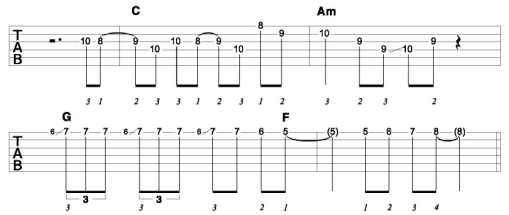
Here it is again with the inclusion of chord fragments:
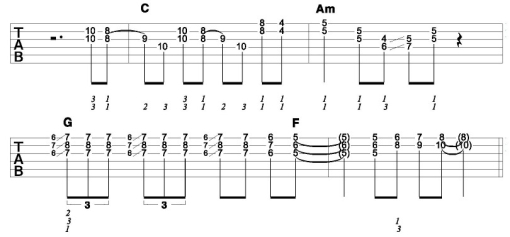
Notice the texture and depth you get with the fragments added. I chose to go all out here and use fragments throughout the whole line. You could use them a little more sparingly if you wish, leaving some single notes in for a nice contrast. It's up to you.
I am also approaching some of the fragments by a fret below in the example above. This adds a nice touch to the line giving it more movement.
There are many ways you can go about adding fragments to your solo lines. This is just one example. You should try it out yourself with your own solo ideas.
It's absolutely crucial that you can visualise where each chord fragment is coming from so that you have the freedom to use them in your improvisations and general playing. You need to be able to immediately visualise the larger shape that the fragment you are using comes from.
As mentioned earlier, a great way to go about this is to think of the larger chord form as the parent and the fragments you break it into as the children of the larger form.
Thinking in this way for our example above, we would get the following:
Chord progression:
C Am G F
Chord fragments:
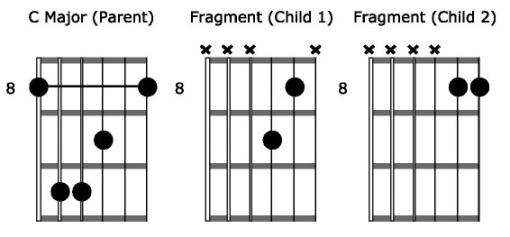
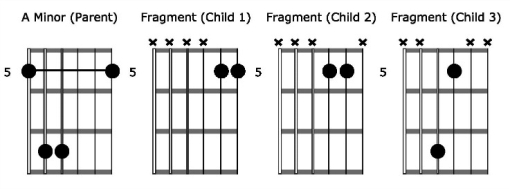
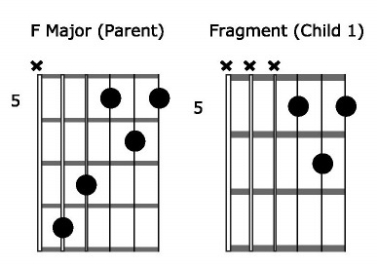
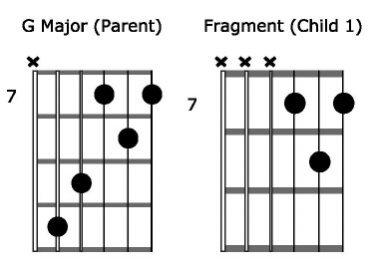
This should clearly illustrate for you how to visualise your chord fragments on the fretboard and organise them accordingly into relationships with the larger chord forms (aka the parent).
Don't underestimate the importance of doing this. It will allow you the freedom to use chord fragments to spice up your acoustic soloing without having to think about it first.
Learn how to improve your acoustic guitar solos right now with this free ebook and audio on how to use chords to solo with on your acoustic guitar.
Specializing in online acoustic guitar lessons, Simon Candy is based in Melbourne, Australia where he runs his own guitar school.